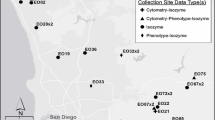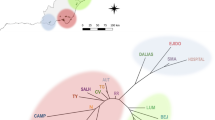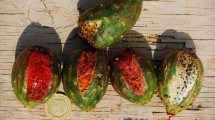Abstract
Expansion of mining in the banded ironstone ranges of southern Western Australia has focussed attention on the genetic impacts of habitat loss on rare endemic taxa. One example is Tetratheca paynterae subsp. paynterae (Elaeocarpaceae), an insect-pollinated, perennial shrub confined to 4 ha of banded ironstone outcrops in the Windarling Range. Mining removed 1,900 of the 7,700 recorded plants in 2004. Further reductions could occur if it can be demonstrated that the viability of the remaining population is not threatened. To investigate the potential impact of reductions in population size due to mining we first used Bayesian clustering and principal coordinate analysis to define population boundaries based on differentiated gene pools. The level of genetic diversity and spatial genetic structuring was then compared among populations that ranged in size from 46 to 4400 individuals. Analysis with 11 microsatellite loci revealed lower genetic diversity in small populations (A R = 4.5–4.8) than a large population (A R = 6.3) together with significant pair-wise differences among populations separated by distances of 80 m or more. Spatial autocorrelation analysis showed the extent of spatial genetic structure differed among populations of different size, consistent with near-neighbour mating and limited dispersal. Fine scale spatial structure was consistent with historically low gene flow. Analysis of the impact of possible expansions in mining revealed small, isolated populations of T. paynterae subsp. paynterae were of high conservation value. While their removal would reduce plant numbers and genetic diversity by less than 5%, unique genotypes will be lost resulting in a 30% decline in genetic differentiation.





Similar content being viewed by others
References
Barrett SCH, Kohn JR (1991) Genetic and evolutionary consequences of small population size in plants: implications for conservation. In: Falk DAI, Holsinger KE (eds) Genetics and conservation of rare plants. Oxford University Press, New York, pp 3–30
Brew CR, O’Dowd DJ, Rae ID (1989) Seed dispersal by ants: behaviour-releasing compounds. Oecologia 80:490–497. doi:10.1007/BF00380071
Bull JP (2007) Tetratheca erubescens (Elaeocarpaceae), a new and geographically restricted species from the Coolgardie Biogeographic Region of south-western Australia. Nuytsia 17:87–96
Butcher R (2007) New taxa of ‘leafless’ Tetratheca (Elaeocarpaceae, formerly Tremandraceae) from Western Australia. Aust Syst Bot 20:139–160. doi:10.1071/SB06015
Butcher PA, Krauss SL (2008) Development of microsatellites from the rare ironstone endemic, Tetratheca paynterae subsp. paynterae and cross species amplification. Mol Ecol Res (in press)
Butcher PA, Moran GF, Perkins HD (1998) RFLP diversity in the nuclear genome of Acacia mangium. Heredity 81:205–213. doi:10.1046/j.1365-2540.1998.00392.x
Butcher PA, Skinner AK, Gardiner CA (2005) Increased inbreeding and inter-species gene flow in remnant populations of the rare Eucalyptus benthamii. Conserv Genet 6:213–226. doi:10.1007/s10592-004-7830-x
Butcher R, Byrne M, Crayn DM (2007) Evidence for convergent evolution among phylogenetically distant rare species of Tetratheca (Elaeocarpaceae, formerly Tremandraceae) from Western Australia. Aust Syst Bot 20:126–138. doi:10.1071/SB06017
Colas B, Olivieri I, Riba M (1997) Centaurea corymbosa, a cliff-dwelling species tottering on the brink of extinction: a demographic and genetic study. Proc Natl Acad Sci USA 94:3471–3476. doi:10.1073/pnas.94.7.3471
Crayn DM, Rosetto M, Maynard DJ (2006) Molecular phylogeny and dating reveals an Oligo-Miocene radiation of dry-adapted shrubs (Tremandraceae) from rainforest tree progenitors (Elaeocarpaceae) in Australia. Am J Bot 93:1328–1342. doi:10.3732/ajb.93.9.1328
Diniz-Filho JAF, Telles MPDC (2002) Spatial autocorrelation analysis and the identification of operational units for conservation in continuous populations. Conserv Biol 16:924–935. doi:10.1046/j.1523-1739.2002.00295.x
Double MC, Peakall R, Beck NR, Cockburn A (2005) Dispersal, philopatry and infidelity: dissecting local genetic structure in superb fairy wrens (Malarus cyaneus). Evolution 59:625–635
England PR, Usher AV, Whelan RJ, Ayre DJ (2002) Microsatellite diversity and genetic structure of fragmented populations of the rare, fire-dependent shrub Grevillea macleayana. Mol Ecol 11:967–977. doi:10.1046/j.1365-294X.2002.01500.x
Evanno G, Regnaut S, Goudet J (2005) Detecting the number of clusters of individuals using the software STRUCTURE: a simulation study. Mol Ecol 14:2611–2620. doi:10.1111/j.1365-294X.2005.02553.x
Falush D, Stephens M, Pritchard JK (2003) Inference of population structure using multilocus genotype data: linked loci and correlated allele frequencies. Genetics 164:1567–1587
Field D, Ayre D, Whelan R, Young A (2008) Relative frequency of sympatric species influences interspecific hybrid production, seed production and seedling performance in the uncommon Eucalyptus aggregata. J Ecol 96:1198–1210
Gibson N, Coates DJ, Thiele KR (2007) Taxonomic research and the conservation status of flora in the Yilgarn banded iron formation ranges. Nuytsia 17:1–12
Goudet J (2001) FSTAT, a program to estimate and test gene diversities and fixation indices (version 2.9.3). Available via http://www2.unil.ch/popgen/softwares/fstat.htm Cited 19 Dec 2007
Hoebee SE, Young AG (2001) Low neighbourhood size and high interpopulation differentiation in the endangered shrub Grevillea iaspicula McGill (Proteaceae). Heredity 86:489–496. doi:10.1046/j.1365-2540.2001.00857.x
Kennington WJ, James SH (1997) The effect of small population size on the mating system of a rare clonal mallee, Eucalyptus argutifolia. Heredity 78:252–260. doi:10.1038/hdy.1997.39
Kimura M, Crow JF (1964) The number of alleles that can be maintained in a finite population. Genetics 49:725–738
Kruckeberg AR, Rabinowitz D (1985) Biological aspects of endemism in higher plants. Annu Rev Ecol Syst 16:447–479. doi:10.1146/annurev.es.16.110185.002311
Lascalles DF (2007) Black smokers and density currents: a uniformitarian model for the genesis of banded iron-formations. Ore Geol Rev 32:391–411
Levin SA, Cohen D, Hastings A (1984) Dispersal strategies in patchy environments. Theor Popul Biol 126:165–191. doi:10.1016/0040-5809(84)90028-5
Lewis PO, Zaykin D (2001) Genetic data analysis: computer program for the analysis of allelic data. Version 1.0(d16c). Available via http://www.eeb.uconn.edu/people/plewis/software.php Cited 19 Dec 2007
Linhart YB, Grant MC (1996) Evolutionary significance of local genetic differentiation in plants. Annu Rev Ecol Syst 27:237–277. doi:10.1146/annurev.ecolsys.27.1.237
Luikart G, Cornuet J-M (1998) Empirical evaluation of a test for identifying recently bottlenecked populations from allele frequency data. Conserv Biol 12:228–237. doi:10.1046/j.1523-1739.1998.96388.x
Luikart G, Allendorf FW, Cornuet J-M, Sherwin B (1998) Distortion of allele frequency distributions provides a test for recent bottlenecks. J Hered 89:238–247. doi:10.1093/jhered/89.3.238
Mayer MS, Soltis PS, Soltis DE (1994) The evolution of the Streptanthus glandulosus complex (Cruciferae): genetic divergence and gene flow in serpentine endemics. Am J Bot 81:1288–1299. doi:10.2307/2445405
McPherson H, Porter C, Rymer P, Crayn D, Rossetto M (2008) Isolation and characterization of polymorphic microsatellite loci from Tetratheca ericifolia (Elaeocarpaceae). Mol Ecol Res (in press). doi:10.1111/j.1471-8286.2008.02093.x
Moritz C (1994) Defining ‘Evolutionarily Significant Units’ for conservation. Trends Ecol Evol 9:373–375. doi:10.1016/0169-5347(94)90057-4
O’Connell LM, Mosseler A, Rajora OP (2006) Impacts of forest fragmentation on the mating system and genetic diversity of white spruce (Picea glauca) at the landscape level. Heredity 97:418–426. doi:10.1038/sj.hdy.6800886
Olivieri I, Michalakis Y, Gouyon P-H (1994) Metapopulation genetics and the evolution of dispersal. Am Nat 146:202–228. doi:10.1086/285795
Paetkau D (1999) Using genetics to identify intraspecific conservation units: a critique of current proposals. Conserv Biol 13:1507–1509. doi:10.1046/j.1523-1739.1999.98507.x
Peakall R, Smouse PE (2006) GENALEX 6: genetic analysis in Excel Population genetic software for teaching and research. Mol Ecol Notes 6:288–295. doi:10.1111/j.1471-8286.2005.01155.x
Peakall R, Rubal M, Lindenmayer DB (2003) Spatial autocorrelation analysis offers new insights into gene flow in the Australian bush rat, Rattus fuscipes. Evolution 57:1182–1195
Piry S, Luikart G, Cornuet J-M (1999) BOTTLENECK: a computer program for detecting recent reductions in the effective population size using allele frequency data. J Hered 90:502–503. doi:10.1093/jhered/90.4.502
Poot P, Lambers H (2003) Are trade-offs in allocation pattern and root morphology related to species abundance? A congeneric comparison between rare and common species in the south-western Australian flora. J Ecol 91:58–67. doi:10.1046/j.1365-2745.2003.00738.x
Poot P, Lambers H (2008) Shallow-soil endemics: adaptive advantages and constraints of a specialized root-system morphology. New Phytol 178:371–381. doi:10.1111/j.1469-8137.2007.02370.x
Pritchard JK, Stephens M, Donnelly P (2000) Inference of population structure using multilocus genotype data. Genetics 155:945–959
Rathbone DA, McKinnon GE, Potts BM, Steane DA, Vaillancourt RE (2007) Microsatellite and cpDNA variation in island and mainland populations of a regionally rare eucalypt, Eucalyptus perriniana. Aust J Bot 55:513–520. doi:10.1071/BT06203
Raymond M, Rousset F (1995a) GENEPOP (version 1.2): population genetics software for exact tests an ecumenicism. J Hered 86:248–249
Raymond M, Rousset F (1995b) An exact test for population differentiation. Evolution 49:1280–1283. doi:10.2307/2410454
Rice WR (1989) Analyzing tables of statistical tests. Evolution 43:223–225. doi:10.2307/2409177
Rossetto M, Kooyman M (2005) The tension between dispersal and persistence regulates the current distribution of rare palaeo-endemic rain forest flor: a case study. J Ecol 93:906–917. doi:10.1111/j.1365-2745.2005.01046.x
Rossetto M, Kooyman R, Sherwin W, Jones R (2008) Dispersal limitations, rather than bottlenecks or habitat specificity, can restrict the distribution of rare and endemic rainforest trees. Am J Bot 95:321–329. doi:10.3732/ajb.95.3.321
Smith S, Hughes J, Wardell-Johnson G (2003) High population differentiation and extensive clonality in a rare mallee eucalypt: Eucalypt curtisii. Cons Gen 4:289–300. doi:10.1023/A:1024077315820
Smouse PE, Peakall R (1999) Spatial autocorrelation analysis of individual multiallele and multilocus genetic structure. Heredity 82:561–573. doi:10.1038/sj.hdy.6885180
Vekemans X, Hardy OJ (2004) New insights from fine-scale spatial genetic structure analyses in plant populations. Mol Ecol 13:921–935. doi:10.1046/j.1365-294X.2004.02076.x
Walter R, Epperson BK (2004) Microsatellite analysis of spatial structure among seedlings in populations of Pinus strobus (Pinaceae). Am J Bot 91:549–557. doi:10.3732/ajb.91.4.549
Weir BS (1996) Genetic data analysis II. Methods for discrete population genetic data. Sinauer Associates Inc, Sunderland, MA
Weir BS, Cockerham CC (1984) Estimating F-statistics for the analysis of population structure. Evolution 38:1358–1370. doi:10.2307/2408641
Young A, Boyle T, Brown AHD (1996) The population genetic consequences of habitat fragmentation in plants. Trends Ecol Evol 11:413–418. doi:10.1016/0169-5347(96)10045-8
Acknowledgements
Funding from Portman Iron Ore Pty Ltd and access to unpublished technical reports is gratefully acknowledged. We also acknowledge support provided by Piers Goodman, James Hesford and Rob Howard from Portman Iron Ore Pty Ltd and Geoff Cockerton from Western Botanical, Colin Yates from the Department of Environment and Conservation for useful discussions on population dynamics and Terry Houston from the Western Australian Museum for identification of pollinators. Stem material was collected under permit No. SW010813 issued under the Western Australian Wildlife Conservation Act 1950.
Author information
Authors and Affiliations
Corresponding author
Rights and permissions
About this article
Cite this article
Butcher, P.A., McNee, S.A. & Krauss, S.L. Genetic impacts of habitat loss on the rare ironstone endemic Tetratheca paynterae subsp. paynterae . Conserv Genet 10, 1735 (2009). https://doi.org/10.1007/s10592-008-9775-y
Received:
Accepted:
Published:
DOI: https://doi.org/10.1007/s10592-008-9775-y




